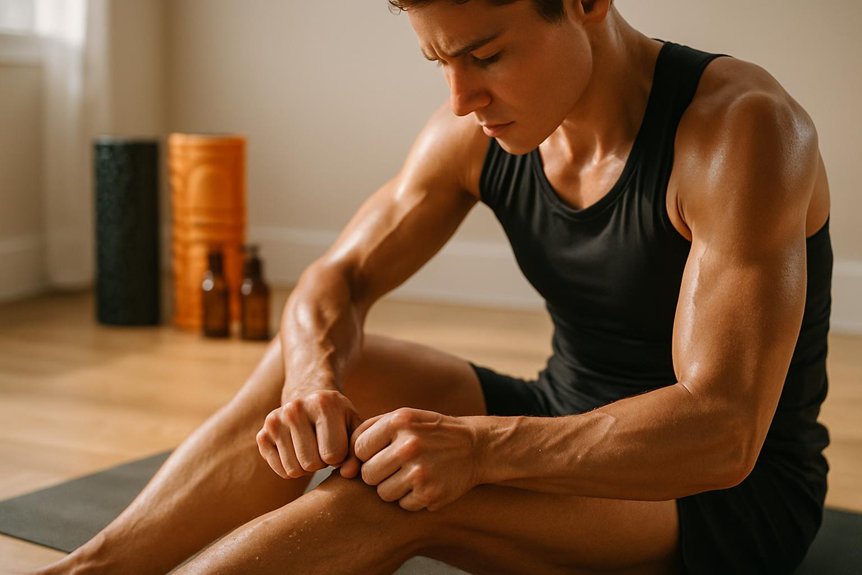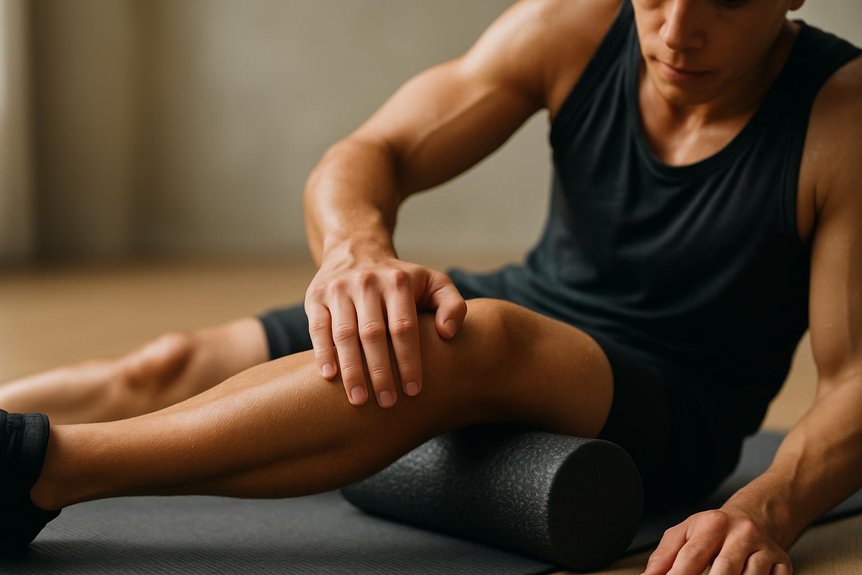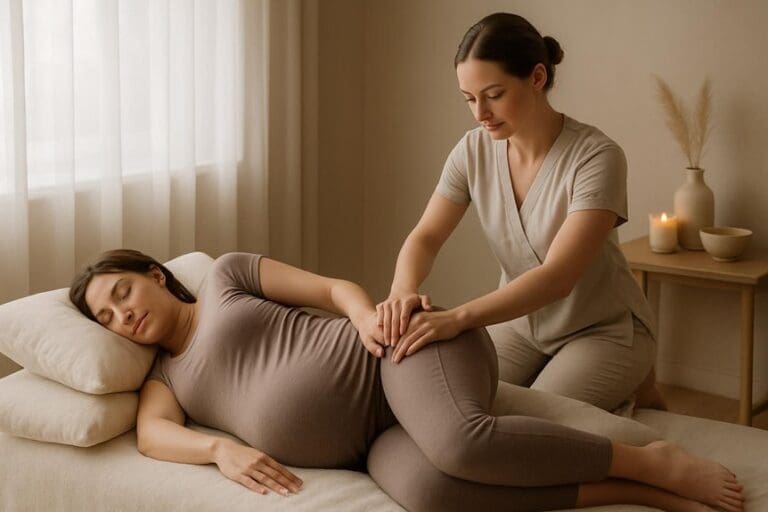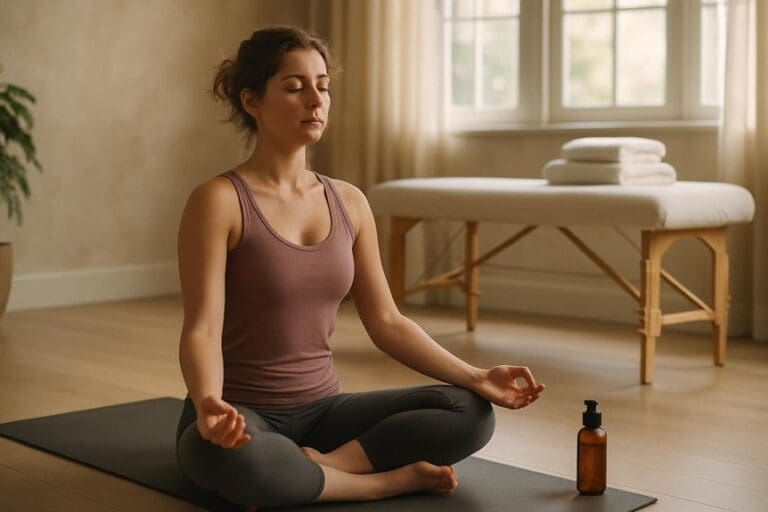Self-administered performance massage involves applying firm, controlled pressure with hands, elbows, or massage tools to muscles, fascia, and tendons, particularly in tension-prone areas such as the trapezius, deltoids, and supraspinatus. Techniques such as effleurage, petrissage, and myofascial release aid lymphatic flow and tissue recovery. A quiet, clean space, hypoallergenic oils, and attention to anatomical landmarks enhance efficacy. Hydration and post-massage stretching support recovery. Ideal results require informed selection of each technique, tool, and post-care practice.
Understanding the Principles of Performance Massage

How does performance massage achieve its therapeutic effects? Performance massage utilizes targeted manual techniques designed to manipulate the soft tissues—primarily muscles, fascia, tendons, and ligaments. By applying varying pressures and rhythmical movements, this modality enhances local circulation, reduces neuromuscular tension, and promotes lymphatic drainage. At Spa & Massage, therapists emphasize anatomical precision, focusing on muscle groups most susceptible to overuse or injury. Trigger point therapy and myofascial release are frequently integrated to address adhesions and restore ideal tissue extensibility. The intervention modulates both the sympathetic and parasympathetic nervous systems, supporting faster tissue repair and improved range of motion. The result is a tangible reduction in delayed onset muscle soreness (DOMS) and enhanced proprioceptive feedback, facilitating the body’s intrinsic healing mechanisms while nurturing overall physical wellbeing. Sports massage shares certain principles and methods with deep tissue massage, such as the use of firm pressure to reach deeper muscle layers and target chronic tension.
Preparing Your Space and Tools
Following an understanding of performance massage principles, proper preparation of the environment and selection of tools establishes the foundation for effective self-application. A quiet, temperature-controlled setting promotes parasympathetic activation, essential for muscular relaxation and ideal tissue response.
The area should accommodate full range of motion and support postural stability. At Spa & Massage clinics, therapists recommend a firm but comfortable surface, such as a yoga mat or padded floor, to facilitate myofascial work and precise pressure application.
Essential tools include clean towels, a set of massage balls or foam rollers for targeted trigger point release, and a bolster or pillow to provide limb support and ergonomic alignment.
Cleanliness of tools and space reduces risk of skin irritation, reinforcing the therapeutic atmosphere valued by Spa & Massage clients.
Choosing the Right Massage Oils and Balms
Selecting appropriate massage oils and balms is vital for ideal tissue glide, skin hydration, and minimizing friction during performance massage.
At Spa & Massage, therapists recommend natural oils for their hypoallergenic properties and compatibility with various skin types.
They also consider texture and scent preferences to enhance the sensory experience.
Proper application techniques ensure even distribution and improved absorption, facilitating effective manual manipulation of muscle fibers.
Benefits of Natural Oils
Why do natural oils play a critical role in performance massage? The application of natural oils, as recommended in Spa & Massage clinics, facilitates ideal glide during manual techniques, reducing friction and minimising dermal irritation. Their lipid-rich composition supports the integrity of the stratum corneum, enhancing epidermal hydration and promoting elasticity in the superficial fascia.
Natural oils, such as those utilised by Spa & Massage therapists, are hypoallergenic and less likely to occlude pores, making them suitable for repeated use on sensitive or compromised skin.
Furthermore, these oils possess inherent anti-inflammatory and antioxidant properties, which may contribute to the modulation of post-exercise muscular microtrauma. By improving cutaneous absorption and tactile comfort, natural oils enable more effective manipulation of myofascial tissues, fostering a sense of physical intimacy and holistic wellbeing during self-massage.
Selecting Texture and Scent
When determining the most suitable massage medium, both texture and scent are critical parameters influencing therapeutic efficacy and sensory experience.
The ideal oil or balm should provide sufficient glide to facilitate deep, controlled strokes over the myofascial tissue without excessive residue. Spa & Massage therapists recommend lighter oils for rapid absorption during performance massage, ensuring minimal interference with tissue manipulation.
Scent, often underestimated, has direct implications for relaxation and mental focus. Subtle, botanical fragrances such as lavender or eucalyptus—frequently used in our clinics—can promote calmness and deepen the sense of connection to one’s body.
For individuals sensitive to fragrance, hypoallergenic, unscented formulations are advisable.
Texture and scent, considered together, enhance both physiological outcomes and the intimate, restorative environment central to effective self-massage.
Application Tips for Effectiveness
Although the selection of massage oils and balms may appear secondary to technique, their proper application is fundamental to optimizing performance massage outcomes.
At Spa & Massage, therapists recommend warming the chosen medium between the palms before initial contact, ensuring even coverage and comfortable temperature upon skin application. Proper lubrication minimizes friction while allowing controlled pressure along muscle fibers, fascia, and tendinous insertions.
Oils with appropriate viscosity support both superficial and deep tissue work, preventing tissue drag and facilitating smooth gliding over anatomical contours. Balms, typically denser, are reserved for targeted areas requiring focused myofascial release.
For self-massage, moderation is key—excess product can hinder grip, while insufficient application may cause discomfort. Thoughtful use of oils and balms enhances tactile connection, promoting effective, intimate therapeutic engagement.
Targeting Key Muscle Groups
To maximise the effectiveness of a self-administered performance massage, precise identification and targeting of primary muscle groups involved in physical activity is essential. Focus should be placed on the major muscle groups most susceptible to overuse or tension, such as the quadriceps, hamstrings, gastrocnemius, gluteal muscles, trapezius, and latissimus dorsi.
Recognising the anatomical location and function of these muscles allows for more accurate and beneficial application of massage techniques. At Spa & Massage, therapists emphasise the importance of tuning into subtle cues of discomfort or fatigue within these regions.
Palpating muscle bellies, noting areas of hypertonicity, and observing symmetry inform targeted intervention. This approach facilitates deeper connection and understanding of one’s own musculature, fostering refined self-care and ideal musculoskeletal health.
Self-Massage Techniques for Different Areas
Addressing specific anatomical regions, such as the lower extremities and the shoulder girdle, requires technique variation to optimize therapeutic outcomes.
Easing sore leg muscles often involves longitudinal effleurage and targeted petrissage along the quadriceps, hamstrings, and calves.
For releasing shoulder tension, practitioners at Spa & Massage recommend focused circular friction and gentle compression applied to the upper trapezius and surrounding musculature.
Easing Sore Leg Muscles
When muscle soreness develops in the legs following physical activity or overexertion, targeted self-massage techniques can promote circulation, decrease muscle tension, and aid recovery in specific anatomical regions.
At Spa & Massage, therapists recommend beginning with effleurage—gentle, gliding strokes along the quadriceps, hamstrings, and calves to encourage lymphatic drainage and warm the tissues.
Progressing to petrissage, individuals should knead and compress the muscle bellies, focusing on areas of palpable tightness or tenderness.
For localized adhesions or trigger points, direct pressure with the thumb or knuckles is applied to facilitate myofascial release.
Using a suitable massage oil, as preferred in our clinics, reduces friction and enhances glide.
Controlled, mindful breathing throughout the session supports a more profound sense of relaxation and connection with the body.
Releasing Shoulder Tension
Frequently, individuals experience tension and discomfort in the shoulder region due to prolonged postural strain, repetitive overhead movements, or acute muscular overload.
Targeted self-massage can facilitate myofascial release in the trapezius, levator scapulae, and supraspinatus muscles.
At Spa & Massage, therapists recommend utilizing fingertips or a massage ball to apply gentle, sustained pressure to palpable trigger points, moving in slow circular motions.
For ideal results, attention should be directed to the superior angle of the scapula and along the posterior deltoid.
Incorporating deep, diaphragmatic breathing during self-massage supports neuromuscular relaxation.
Applying a warming oil, as used in our clinics, enhances tissue pliability and comfort.
Regular self-care, combined with periodic professional performance massage, promotes sustained shoulder mobility and reduces musculoskeletal tension.
Managing Pressure and Avoiding Injury

Although self-administered performance massage can be effective for muscle maintenance, improper pressure application poses a risk of tissue damage or exacerbation of existing injuries. Individuals must maintain awareness of anatomical structures such as muscle bellies, tendons, and neurovascular bundles, and apply graded pressure using fingertips, palms, or massage tools.
At Spa & Massage, therapists recommend beginning with light effleurage to assess tissue sensitivity before progressing to deeper techniques.
Pain should never exceed mild discomfort; sharp, radiating, or persistent pain indicates excessive pressure or potential injury.
Continuous feedback from one’s own body—such as changes in skin coloration, swelling, or altered sensation—guides safe technique.
Incorporating Stretching and Mobility
Integrating targeted stretching and mobility exercises immediately following self-administered performance massage enhances tissue pliability and joint range of motion. Lengthening muscle fibers post-massage, when tissues are ideally perfused and warmed, promotes greater elasticity and neuromuscular relaxation.
Static and dynamic stretches, focusing on agonist and antagonist muscle groups, help maintain fascial glide and minimize residual tension. Gentle, controlled movements—such as active isolated stretches or slow joint articulations—support synovial fluid distribution, fostering joint lubrication and proprioceptive acuity.
At Spa & Massage, therapists routinely recommend customized stretching protocols tailored to individual anatomical needs following performance massage. This integrative approach reinforces the therapeutic effects of manual therapy, encouraging lasting flexibility and resilience.
Clients are guided to respect tissue limits, fostering a deeper, more intimate connection with their physical well-being through mindful movement.
Aftercare: Supporting Recovery and Results
Proper aftercare is essential to maximize the physiological benefits of self-administered performance massage and reduce the risk of adverse tissue response.
Immediately following massage, Spa & Massage therapists recommend gentle hydration to facilitate metabolic waste clearance and tissue perfusion.
Application of a cool compress may mitigate localized inflammation, while targeted static stretching supports elongated muscle fibers and maintains flexibility gains.
Clients are advised to avoid strenuous activity for at least several hours, allowing the neuromuscular system to recalibrate.
At Spa & Massage, post-session guidance often includes self-assessment for delayed onset muscle soreness or abnormal discomfort, ensuring prompt intervention if needed.
Consistent aftercare, including adequate sleep and proper nutrition, enhances soft tissue recovery and augments the therapeutic outcomes of both self-massage and professional treatments.
Conclusion
In conclusion, self-administered performance massage, when executed with anatomical precision and clinical technique, effectively alleviates myofascial tension and promotes musculoskeletal recovery. For instance, a recreational runner experiencing delayed onset muscle soreness (DOMS) in the gastrocnemius may employ cross-fibre friction and effleurage to expedite tissue repair and reduce discomfort. Integrating such evidence-based practices into self-care regimens can sustain muscle health and optimise functional performance between sessions with qualified professionals.



